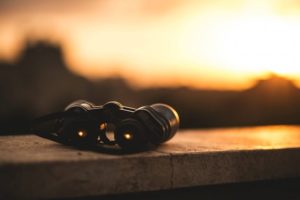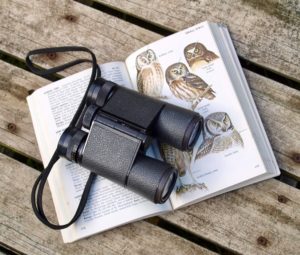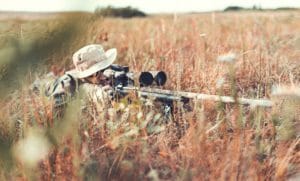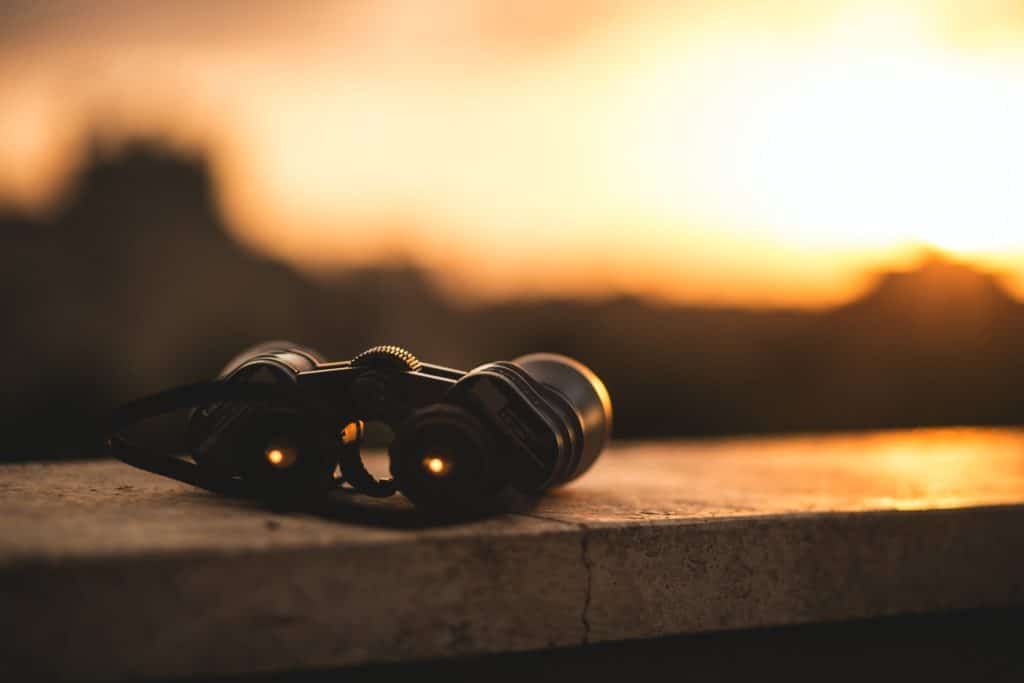There’re lots to consider when buying binoculars. Be it online or in a brick-and-mortar store. Knowing what you’re looking for will save you a great deal of time and help you find a quality product that meets your needs. Now, with that out of the way, here is our binoculars buying guide.
The factors you need to consider when buying binoculars include:
- Magnification
- The objective lens diameter
- Exit pupil
- Eye relief
- Field of view
- minimum/close focus distance
- Interpupillary distance
- Twilight factor
- Optical glass and prism glass
- Coating
- Housing style
- Waterproof and fog proof
- Chassis materials
- Warranty
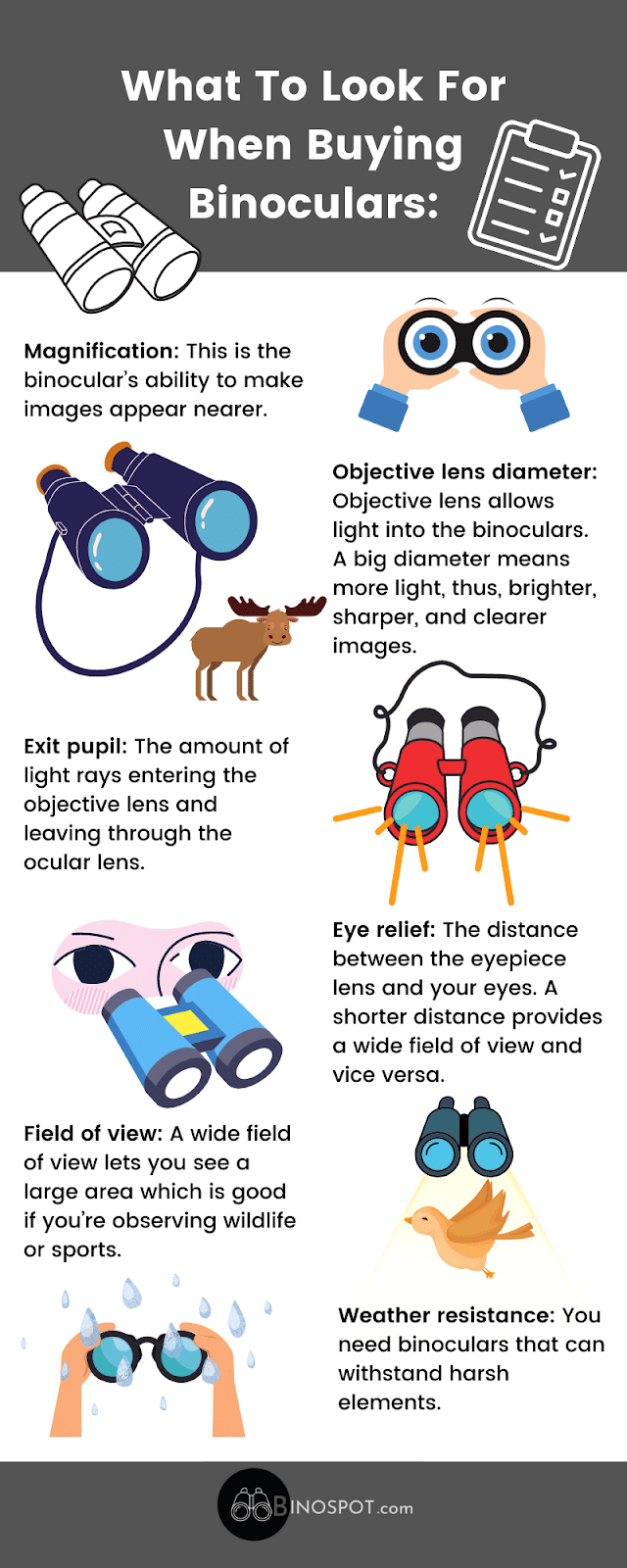
Understanding the Basics
To choose the right pair of binoculars, you must understand their features and how these influence performance. We’ll take you through the basics so that you can make an informed decision.
To start with, you can define binoculars as tools that use a series of lenses, prisms, and elements to magnify your view of people, things, and places that are far away.
They have two optical tubes that make them comfortable to view with both eyes simultaneously. The body design and size are the main differentiating factors in binoculars.
Binoculars Designs
Under design, you’ll find that the difference between optics stems from the prisms inside them. The prism is a component that the binoculars use to reflect light from the objective lens and invert your view vertically and horizontally so that by the time it gets to your eyes at the end of the eyepiece lens it appears natural.
These two prism designs are:
Roof Prism Binoculars
The body design of these binoculars is the letter “H.” it’s basically a set of two tubes running parallel to each other. Therefore, it’s a straight path from the eyepiece to the objective lens. This design is simple, compact, and easy to handle.
Inside, you’ll find a more complex design and alignment of the prisms where they meet a 90 degrees angle. They resemble a building’s roof, hence, the name “roof prism.”
When the light comes in from the lens closest to the target, it reflects on the prisms five times before coming out and heading towards the eyepiece.
The best use for roof prism binoculars includes wildlife viewing, game hunting, bird watching, hiking, and sporting events.
Pros
- Compact and lightweight.
- Easy to weatherproof.
- Better impact resistance than Porro prism.
cons
- You need advanced technology to manufacture.
- More internal light reflections could lead to loss of light.
- More expensive than Porro prism.
Porro Prism Binoculars
Porro Prism Binoculars have the letter “M” design. This bent shape is a result of the zig-zag alignment of the optical path inside the tubes. It looks like it’s a complex design, but it’s actually the easiest to set up.
Two right-angled prisms are usually positioned adjacent to each other inside the tubes. One will have its rectangular face pointing towards the objective lens to receive light, while the other points to the eyepiece lens.
When the light comes in, it goes through internal reflection on the prism’s two sloping faces before bouncing to the other prism. Here, it also reflects on the two sloping faces then heads out. In total, the light reflects four times. This helps to turn the image to a forward and upright position.
Porro prism binoculars are reliable when used in hunting, hiking, sporting events, observing wildlife, and bird watching.
Pros
- Produces better image quality.
- Has a larger objective diameter, hence brighter images.
- Low cost.
- Reflective internal surfaces, therefore, there’s no loss of light.
Cons
- Bulkier compared to the roof prism.
- Usually not waterproof.
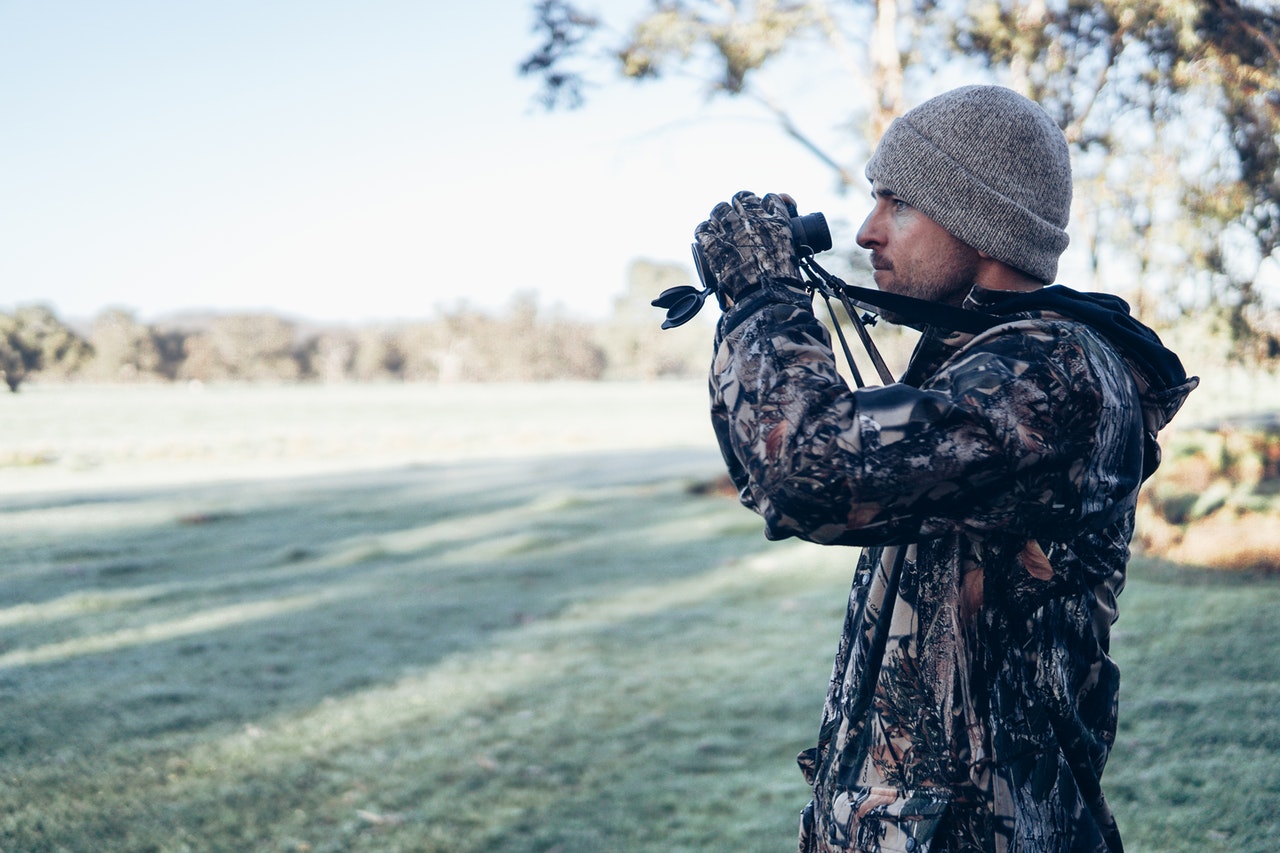
Features and Specifications — What to Look for When Buying a Pair of Binoculars
Magnification
All binoculars have two numbers written on their casing, e.g., 10X42 or 8X25. The first number is usually the optics’ magnification. In the examples above, they would be the numbers 10 and 8. This means they can make the view through them appear 10 or 8 times closer.
For example, if you’re using the 10X42 optics to view a bird that is 1,000 feet away, it will appear as though it’s just 100 feet away.
The ideal magnification varies depending on where you’ll use the binoculars. For instance, while outdoors watching wild animals or sports, a 7X and above magnification power will serve you well. But, while indoors in a theater, you need binoculars with less magnification power (between 3 – 5X) for better viewing.
If you plan to go for binoculars with higher than 10X magnification, then you should also look for a tripod to support their weight because you can’t hold them steady for long. Plus, a slight shake of binoculars with high magnification results in blurred images. That’s why the latest digital binoculars come with inbuilt image stabilizers.
Zoom Binoculars
Zoom binoculars, unlike regular optics, can adjust their magnification power. The numbers on the casing of these binoculars will read something 10-30X60. This means 10 is the minimum magnification while 30 is the highest.
You can adjust between the two using a thumb lever/wheel. It’s strategically within reach so that you don’t have to alter your grip or take the eyepieces from your eyes.
Unfortunately, as much as zoom binoculars offer versatility, you’ll notice some degradation in the image’s brightness and sharpness when zooming between the ranges. This is because the optimization of the prisms’ optical path and workings is at one magnification power. Therefore, moving away from it affects the image.
Objective Lens Diameter
The second number on the casing is the diameter of the objective lens. Its measurements are in millimeters, and you can locate it on the opposite side of the eyepiece, closer to your target.
Its measurement is important because the lens determines the amount of light entering the binoculars. Suffice to say, the larger the diameter, the more the light and vice versa.
More light means that the images will be brighter, extremely fine, and clear (all other factors being constant). This massively helps whenever you’re dealing with low-light situations.
The challenge with large objective lenses is their bulkiness. They can be tiring to carry around, let alone hold steady for extended periods while observing things from a distance. You should consider investing in a tripod stand. It’ll relieve your hands of the daunting task and ensure you enjoy a great viewing experience.
In general, binoculars with objective lens diameters above 30mm (1.2 inches) are standard-sized binoculars. Anything below this falls under compact binoculars. And, if it’s way above 40mm (1.6 inches), then they’re full-size binoculars.
The Exit Pupil
The exit pupil is a circle of bright light that leaves the binoculars through the eyepieces. You will notice it when you hold the binoculars a few inches from your eyes. It’s usually at the center of the eyepieces.
You can calculate its diameter by dividing the objective lens diameter by the magnification. For example, binoculars that are 10X42 will have an exit pupil with a 4.2mm diameter. This is important because the exit pupil diameter has to be bigger than your eye pupil to see correctly.
Your pupil’s diameter ranges from 1.5mm when the light is bright to around 8mm when darkness sets in.
Whenever the exit pupil is smaller than your eye pupil, the binoculars will feel like a peephole. It’s even worse in low light conditions when your pupil diameter widens. This ends up straining your eyes.
You should also know that the human pupil dilates less as a person ages. Therefore, the elderly need to get optics with larger exit pupils.
For zooming binoculars, their exit pupil diameter is usually good when the magnification is low but ends up becoming small as soon as the magnification power goes up. For instance, a 10-30X60 pair of binoculars will have a 6mm exit pupil diameter with 10X low magnification and a mere 2mm with 30X high magnification.
Eye Relief
This is the comfortable distance from the eyepiece lens to your eye, that allows you to view the image clearly. It’s important for people who use eyeglasses or sunglasses.
Most binoculars come with eyecups on the eyepieces. They enable users to place their eyes at a reasonable distance from the eyepieces for ease of use.
You can adjust the eyecups to set the ideal eye relief distance for yourself.
There are some optics with a dioptric adjustment on one end of the eyepieces. Its work is to adjust the focus of either of the lenses to the point that’s comfortable for the user’s eye(s).
The correct eye relief could even let you use the binoculars without glasses. So, if you have a problem with only one eye, the dioptric adjustment will sort you out.
You need to find binoculars with an eye relief that’s not too long or too short because either of the two will constrict your viewing.
For people with eyeglasses, a minimum of 16mm eye relief can help fix the inadequate field of view. However, you must take into account the size of your glasses.
Even though most manufacturers print the eye relief in the specs, it’s essential to try the optics before buying to get an idea of how they feel.
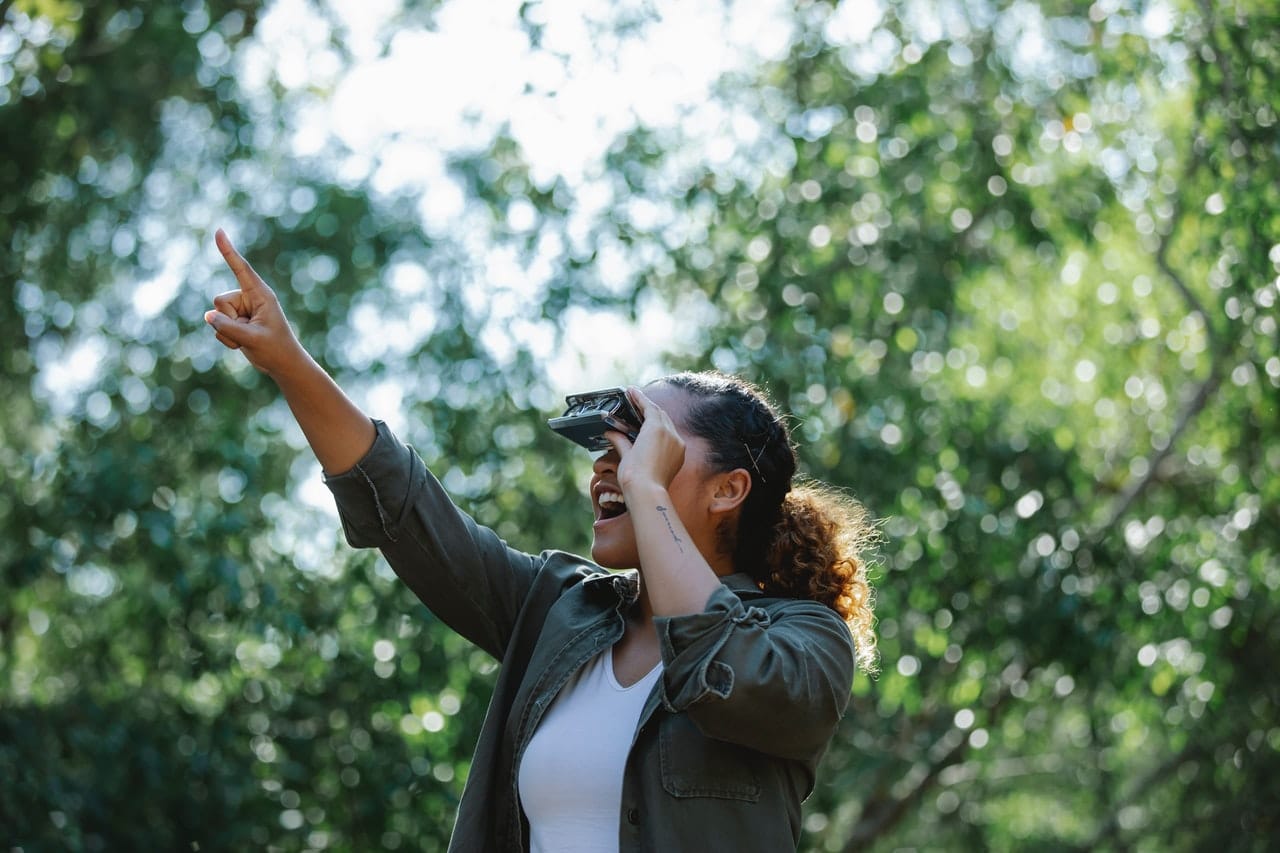
Field of View (Fov)/ Angle of View (Aov)
This is the width of the area (in feet) that you can observe through the binoculars at 1,000 yards. A higher field of view number means you can see a wider area. Hence, it’s most suitable for viewing moving objects.
A smaller number, on the other hand, allows you to see a narrower region. It lets in less light which may lead to slightly darker images.
You can also measure the FOV in degrees. In that case, it becomes the angle of view (AOV). Most optics have their AOV at 6 degrees and 7.5 degrees. Whenever you see two different measurements in degrees, one is the “real angle of view” while the other is “the apparent angle of view.”
You get the apparent AOV by multiplying the magnification by the real AOV.
Some of the factors that impact your field of view include the eyepiece design, focal length of the objective lenses, and magnification power (high magnification results in a narrow FOV).
These and other factors can cause a huge disparity in fields of view among binoculars with similar specs.
Your choice of field of view will depend on what you’ll be using the binoculars for. If you’re browsing a wide-open area, then a narrow field of view will serve you perfectly. But, if you’re scanning for wild game at ranges of 100 yards in a thick forest, then you’ll need optics with wider fields of view.
Minimum/Close Focus Distance
This feature goes against the sole purpose of binoculars for most users — to observe long-distance objects. However, for those who enjoy watching insects and birds that are near, at close range, the minimum focus distance is important.
It lets you see minute details of the animals, like wing bars, crown markings, etc. for any good binoculars, a close focus distance of 6 feet or below is okay. You should know that an increase in magnification increases the close focus distance.
Look for binoculars with a large objective lens and a magnification of around 8X. Or, you could buy binoculars that are meant explicitly for minimum focus.
Interpupillary Distance (IPD)
This is the distance between your two eyes. The eyepieces should fit squarely on each eye while the center of the optic rests on the bridge of your nose.
Make sure you go for binoculars that let you adjust the distance between the eye cups if your eyes are close or far apart.
The Twilight Factor
You calculate the twilight factor by multiplying the objective lens (in millimeters) by the magnification, then getting your result’s square root.
The resulting number indicates the effectiveness of binoculars in low light conditions. A high number means the binoculars can view more detail in low light conditions.
Optical Glass, Prism Glass, and Coatings
The quality of optical glass and lens coatings are important considerations when looking to buy the best binoculars. Let’s find out why.
Optical Glass
Binocular optics work in such a way that light gets in through a glass lens and leaves through another glass lens on the opposite end. It goes without saying that glass is integral to the optimal performance of binoculars. And, not just any glass — superior quality glass.
Binoculars glasses serve the following functions:
- Reflecting enough light.
- Transmit the required amount of light near the field of view.
- Produce an upright image.
- Maintain the correct light waves inside the tube.
- Allow more than enough light into the tube (it’s never enough).
With all these on the line, you can’t risk having an inferior quality glass in your pair of binoculars.
One of the highly-rated lens glasses to look for is the ED glass (Extra-low dispersion glass).
ED Glass
Unlike the regular glass lens, ED glass is very good at preventing light dispersion (also known as chromatic aberration). It focuses light wavelengths precisely, thereby producing sharp and clear images.
The challenge with ED glass is that it’s not stable under drastic temperature changes. This leads to a change in focal length, which could affect the quality of the image. To be safe, you should avoid using it in harsh weather conditions.
Some binoculars use Eco-glass lenses for enthusiasts of ecologically friendly products (they don’t have arsenic or lead compounds).
Prism Glass
Under prisms, we have the BK7, SK15, and BAK4 glass. These are the materials that make up the Porro and roof prisms. They have a lot of impact on the image quality.
BAK4 (Barium Crown Glass)
BAK4 is the best prism material of the three. It’s a fine, high-density reflective glass with a refractive index of 1.5688.
The higher refractive index rate and low critical angle, coupled with its exit pupil’s full, round shape, make BAK4 prism glass a better light transmitter. As a result, you get images that are brighter, sharper, and rich in color.
The only drawback is its high cost which increases the overall price of the binoculars.
BK7 (Boro-Silicate Glass)
BK7 is known for being highly reflective and boasts of a 1.5168 refractive index rate. This is the most popular prism material in use.
Unlike the BAK4, this prism has a square-like exit pupil, complete with cut-off edges. This usually makes your viewing darker and leads to loss of color on the edges of your field of view. An increase in the field of view worsens the situation.
SK15
The qualities of the SK15 glass make it a perfect balance between the BAK4 and BK7. Its refractive index rate is the highest of all three, but the dispersion falls behind that of BAK4. Nevertheless, it does a decent job of curbing internal light reflections.
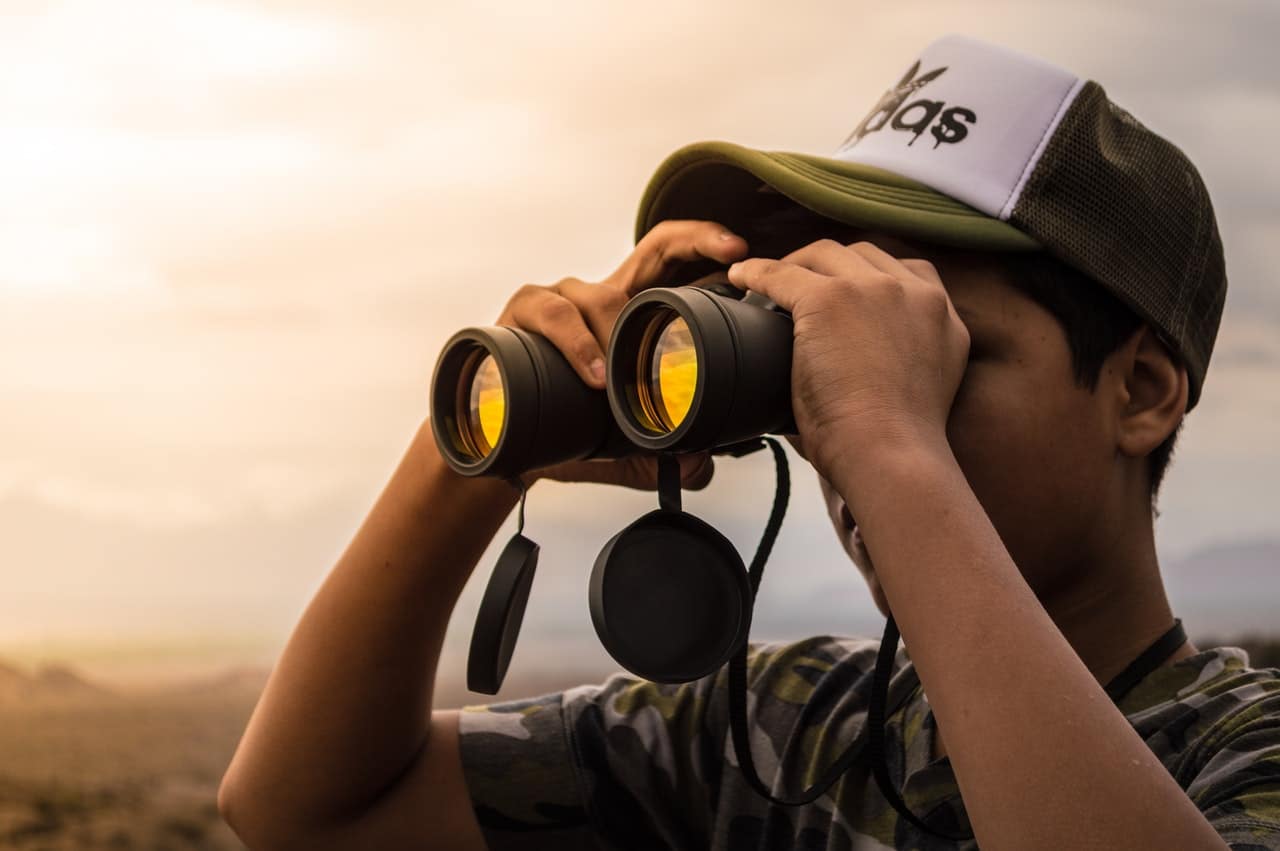
Coating for Lens and Prisms
Light reflections are the greatest hindrance to light transmission in binoculars. This is because a good percentage of the reflected light remains in the binoculars and causes glare.
Fortunately, you can eliminate the reflections by coating the glass surface or prism with a thin chemical film (the common one is magnesium fluoride). This will reduce the loss of light and glare. As a result, more light passes through, thereby producing brighter and clearer images.
When you apply several layers of coating on the glass, the light reflection component reduces significantly. Sometimes between 0.25 and 0.5 percent on each glass surface.
The coating application must be perfect for you to enjoy its full effect. It should be even in terms of coverage and thickness. Unfortunately, it’s hard to spot unevenness in the coating without the help of specialized equipment.
If you notice certain coatings with different colors, don’t worry because that doesn’t directly affect the image quality. It’s just that the chemicals used and the number of coating layers tend to alter the color from blue, violet, red, green, or even yellow.
Be vigilant when analyzing binoculars’ coatings. This is the one area where you can easily get confused and end up with a substandard product. To help you out, here are coating terms you must know:
Coated
One or more glass surfaces on at least one of the lenses have one or more coating layers.
Fully Coated
All glass surfaces have an anti-reflective coating.
Multi Coated
One or more of the glass surfaces on at least one lens have one or several anti-reflective coating layers.
Fully Multi Coated
All the glass surfaces that are inside or outside the tube have several layers of anti-reflective optical coating.
Dielectric Coatings
This is a superior type of prism coating that allows close to 100 percent of light to pass through. It boosts internal reflection significantly and leads to the production of clearer images with high contrast.
Silver-Mirror Coating
Silver-Mirror Coating has a reflectivity of 95 to 98 percent. The only challenge with using the silver-mirror coating is that they oxidize and lose their reflectivity with time if the binoculars aren’t sealed properly.
Phase Shift Coating
This special type of dielectric coating is applied to roof prisms to correct the loss of light on the horizontal image plane. The loss and distortion of the light path happens when the objective lens’s reflection hits the roof prism. It gets and forms two wavelengths which travel separately and at different speeds towards the eyepiece.
Usually, one beam of light will get to the eyepiece before the other, which messes up the image quality and appearance. The resolution’s contrast suffers the most.
The phase shift coating helps to maintain the same polarization for the two light paths, so they arrive simultaneously.
Water-Repellent Coating
A water-repellent coating doesn’t improve reflectivity but makes it easy to use the binoculars in wet environments and weather conditions.
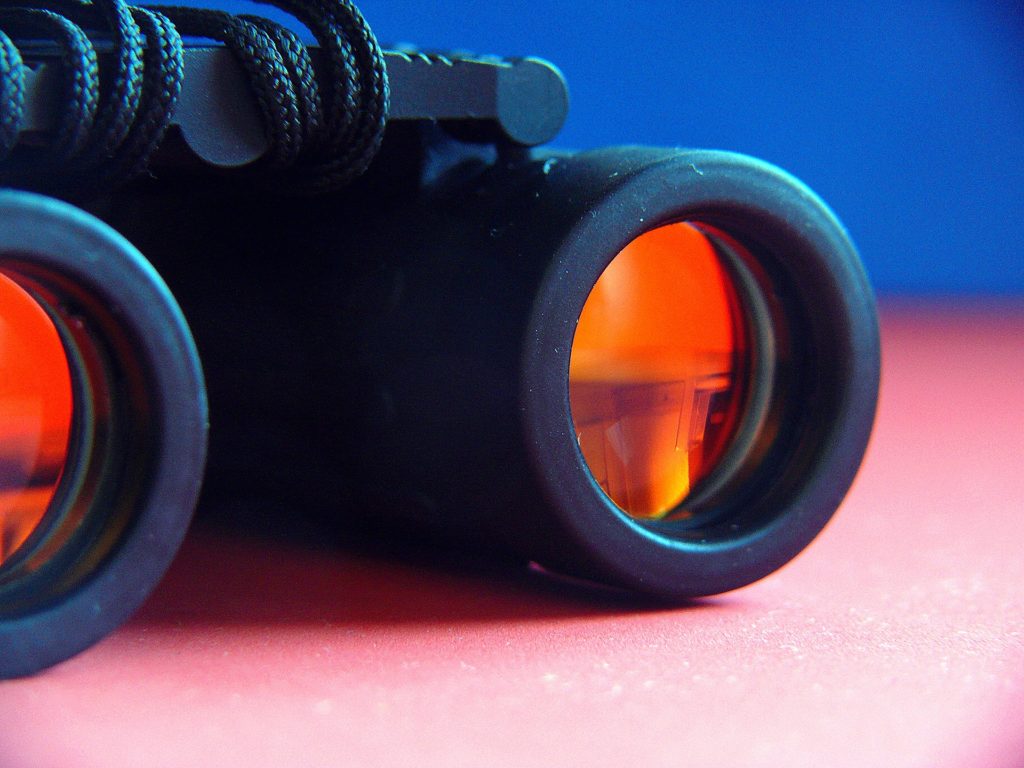
Housing Styles
The housing style may not influence the quality of the image, but it impacts your ease of use. Here, you’ll come across the open and close bridge design.
In the close bridge, the center hinge and focus control mechanism are part of the housing. This makes the hinge solid and steady. But, it prevents your hands from wrapping around the body.
The open bridge, on its part, has the focus control near the eyepiece. Then, there is a stabilizing component installed near the objective lenses. This leaves the center open to accomplish the full wrap-around grip that is firmer and more comfortable.
Waterproofing and Fog Proof
Considering most binoculars are outdoor products, it helps to buy those that can survive the harshest weather elements. This will ensure they work well regardless of when you use them.
Waterproofing
Waterproof binoculars use O-rings or gaskets to seal out any form of moisture. They also prevent dust from getting in. Different models are submersible for varying lengths of time.
If you’re planning to use your binoculars in the seas or around water bodies, you’ll be better off with a high-end model that’ll remain undamaged even when it stays in water for a long time.
Be sure to check the actual IPX waterproof rating of the optics. The best product, in this case, would be one with an IPX 7 and above.
Fog Proof
Fogging in binoculars takes place when the air mixes with moisture inside the optical tubes. As a result, when you move the binoculars from the warm air indoors to the frigid atmosphere outdoors, the moisture inside the tube condenses and forms fog on the inside.
To prevent this from happening, manufacturers usually pump inert and dry gases like argon and nitrogen, or both, inside the optical tubes—under pressure.
Firmly situated O-rings and gaskets prevent leaks. The longer the gases stay intact inside the tubes, the longer the binoculars stay fog proof.
One thing to note is that, while all fog-proof binoculars will be waterproof, NOT all waterproof binoculars will necessarily be fog proof.
Chassis Materials
The chassis is the outer body that encloses the optics. The different materials used to manufacture it include alloys of:
Magnesium
Magnesium alloy’s strength-to-weight ratio makes it a popular choice. You can hold binoculars made of it for long periods without getting tired—eliminating the hassle of carrying a tripod around.
It’s also strong enough to survive abuse and harsh elements. Not forgetting its corrosion-resistant ability.
The downside with the metal alloy is its susceptibility to expansion and contraction when exposed to different temperatures.
Aluminum
This is the most popular of all the chassis materials because of its light weight, strength, corrosion resistance and affordability. Working with it is also easy.
Polycarbonate
Polycarbonate is a polymer resin with diverse formulas and properties. It’s corrosion-proof, strong, inexpensive and easy to work with.
Unlike the metal alloys, it’s not affected by temperature changes. So, you can take it to extreme weather conditions and not worry about it expanding or contracting.
Note: be wary of fancy terms like “aero-space grade” that manufacturers use to try and make the chassis material seem like it’s superior. Instead, look for verifiable specifics.
Rubber Coating
This isn’t a chassis material but can help guard the chassis and other internal components of the binoculars against rough handling, falls, and bumps and bruises. Plus, it provides a good grip on the binoculars even when it’s wet.
Warranty
You should always look at the warranty that the manufacturer is offering for the binoculars. It can help you separate reliable products from low-quality ones.
Binoculars are a long-term investment that ought to last. A manufacturer who trusts the quality of his models wouldn’t have a problem providing extended warranties.
How to Focus Your Binoculars
First, before you start using the pair of binoculars, adjust the eyecups. For those who wear eyeglasses, retract the eyecups and fold the rubber back. If you don’t wear eyeglasses, extend the eyecups to their maximum and set the rubber up.
Next, check the eye relief and adjust the interpupillary distance to fit your eyes. Failure to do that causes a bad match of the binoculars to your face/eyes, leading to blurry images or double vision. Adjust until the image is clear.
Many of the best binoculars have the central control that adjusts the focus of both oculars simultaneously. Then there’s the diopter adjustment ring on the side of one of the eyepieces’ barrel. It fine-tunes the focus of your view to match your personal optic requirements.
Some binocular models have integrated their diopter adjustment into the central control.
Individual/Independent Focus
This model doesn’t utilize the central control mechanism. Instead, it allows each eyepiece to focus separately.
As a result, you end up with fine and perfect focusing. It’s mostly found in marine and astronomical binoculars. It performs better if you don’t switch the focus often, so it’s not ideal for an optic that you’ll be sharing.
Focus-Free
These binoculars have zero focusing mechanism. Except for the eyepiece adjustments, which are set according to the user’s eyes.
You should keep away from this model if your eyesight is poor, to avoid eye strain. They’re only effective for a limited range—which isn’t extensive.
Binoculars for Different Occasions
To get a much better understanding of what you need to go for when searching for the ideal pair of binoculars, we’ll look at the best binoculars for different uses.
Birding and Watching Nature
If you’re not concerned about the binoculars’ size and weight, you should go for middle-size and full-size models.
A wider field of view and magnification between 7X and 12X will ensure you don’t miss a thing (8X32 and 8X42 are very popular with bird watchers). They should also be fog proof.
Backpacking and Hiking
In this case, you’ll have to work with compact binoculars because of the size and weight concerns when backpacking and hiking. Magnification of 8 or 10 and an objective diameter below 28 will do a good job scanning up or down the hills.
It’ll also help if they’re waterproof and have a good lens coating that works well in rising and setting sun conditions.
Theatre/Museum
For indoor use, you’ll need compact, lightweight binoculars with low magnification. Between 4X and 10X would be effective in a theatre, depending on where you’ll be sitting.
The magnification has to be low in a museum with a focusing distance of less than 2 yards.
Sports
For sports binoculars, a wide field of view is essential if you don’t want to miss a single moment. Look for magnifications of around 7X to 10X. A zoom function would be perfect in this case.
Astronomy
For these binoculars, you need to maximize the magnification and lighting capability of a full-size optic. A good range would be between 10X42 and 10X50. In case you decide to go higher, make sure you have a tripod.

Special Purpose Binoculars
Image-Stabilized
The same image stabilization that you’ll find in digital cameras is now in some binoculars. This feature makes it easy to use the binoculars inside an aircraft or on a boat. It ensures you get a stable view even with strong aircraft vibrations or boat movements.
They are very popular with boaters, search and rescue experts and aviators. The binoculars use these three methods to provide stabilization.
- The first utilizes internal gyroscopes, which help to move prisms to counter the shaky movements.
- The second is electronic stabilization, where minute accelerometers measure the magnitude of movements and send commands that lead to an adjustment of prisms.
- Lastly, there’s mechanical stabilization which uses small counterweights and balances to counter the motions.
Rangefinders
Rangefinders are highly sophisticated binoculars with an infrared (IR) laser which measures accurate distances from the objective lens to a target in feet or meters. The figure is then displayed on the eyepieces instantly.
People use them for a wide range of purposes. Let’s start at sea, where they can easily calculate the distance to another vessel, an object (read iceberg), or even something that’s on the water.
Then some golfers use rangefinders to measure their swing. If you get ones with an inclinometer, you’ll be able to read uphill and downhill angles.
They’ll then use this angle and distance to your target to develop an adjustment that predicts your shots. You can use the figures to adjust accordingly.
Not to forget hunters who use this optic to get the perfect range to the game they’re hunting. With the latest versions being able to update the distance of moving subjects, hunters are sure to enjoy their hunting.
Marine Binoculars
The first thing you’ll notice about these binoculars is their polycarbonate housing. This rust-free, temperature-resistant material is ideal for saltwater environments and other extreme weather conditions. There are those with bright colors for easy visibility, while others are buoyant.
You’ll find some with digital or analog compasses. To read the bearings, you have to check the field of view. Make sure you stock enough batteries since they’re the main source of power for the digital compass.
Digital Camera Binoculars
The integration of digital cameras and binoculars is one of the best things to happen to optics.
With camera resolutions that are as high as 13MP, a sharp and clear display screen, and expandable memory, you can now capture everything you scan — in picture and video form. The interface is very user-friendly.
This is likely to boost the use of optics around the world. Seeing as you don’t have to carry lots of equipment to capture distant views and objects, and store them for future reference.
These binoculars do it all for you. Your only worry should be to find a memory card with ample storage space.
Accessories
Accessories are also crucial considerations when shopping for the best binoculars. Most of them make it easier to use the binoculars or keep them pristine.
Tethered Caps
Keep your objective lens covered with these caps.
Rain Guards
These help to cover the eyecups whenever it rains.
Tripod Adapters
Tripods are essential when working with large binoculars because it’s hard to keep them steady for long holding them with only your hands.
First, you should check if your optic has an in-built tripod mount. If not, get a tripod adapter to help you mount the optic on a tripod stand.
Harnesses
For many users, the strap that’s sold with the binoculars is more than enough. However, there are longer, adjustable, ergonomic, and padded varieties to pick from if you need enhanced functionality.
You can get one that straps the optic tight to your body so that it doesn’t shift while running.
Others redistribute heavy binoculars’ weight towards the back and shoulders — to avoid straining the neck.
Cleaning Kits/Supplies
Accessories help to keep your binoculars pristine so that they can perform at optimum levels and last long. You should invest in the best optical cleaners, solutions, cloths, and pens.
Digiscoping
How about taking photos of the magnified view using your phone? A digiscoping adapter will help you achieve that with ease. They make it possible to attach your phone to either of the eyepieces and capture different views. This is a good option if you can’t afford the digital camera binoculars.
Brands to Watch Out For
Some of the brands to look out for in your quest for the best binoculars include:
Steiner
Steiner binoculars rank among the best in the world because of their outstanding performance, durability, and clear optics. They offer a wide range of optics for different groups of people to serve varying purposes. From the amateurs to serious hunter/tournament shooters and military personnel too.
You can’t miss something that matches your needs. The company uses some of the best materials around to create top-quality products.
Nikon
For a company that has been top of its game for more than a century, it’s safe to say that Nikon has mastered their craft. Their reputation is solid as far as manufacturing the best binoculars at reasonable prices goes.
Nikon has got you covered if you need binoculars for hunting, bird watching, nature walks, astronomy, golfing, or watching theatre. Their attention to detail and rich understanding of optics are second to none.
To show you just how much trust they have in their binoculars models, they offer a 25-year warranty for each one of them.
Bushnell
The name Bushnell is almost synonymous with binoculars. That’s because the company revolutionized the binoculars industry by making the products widely available to the average person.
The quality of their products is quite notable. They are effective for high performance and durability.
Fujinon
When it comes to high-end optical performance, Fujinon binoculars rank highly among maritime commanders and other sea users. These optics have one of the best optimizations for high contrast. Nothing can skip your view when you have these binoculars as your viewing aid.
The other superior brands include; Zeiss, Eagle Optics, Carson, Bresser, ATM, AGM, Maven, Pentax, Olympus, Leica, Canon, Celestron, Swarovski, and Bino Brands.
Frequently Asked Questions
Which One Is Better 8×42 or 10×50 Binoculars?
In terms of performance, the 10X50 binoculars take the day. The 50mm (2 inches) objective lens gathers more light than the 42mm (1.68 inches) diameter. Add that to the 10X magnification power, and you’ll be able to see brighter and finer images than those on the 8X42 binoculars.
When it comes to size, the 10X50 binoculars are larger because they need a big body cover for the 50mm objective lenses.
If you have an issue with a big and heavier binoculars frame, you could consider the 8X42 binoculars.
As for suitability, the 8X42 specs are perfect for everyday use binoculars. You can use them for bird watching, traveling, or even hiking. The 10X50, on the other hand, is suitable for hunting. The powerful magnification enables you to have a clear view of your target.
Which Is the Best Magnification for Binoculars?
That largely depends on the use of the binoculars. Magnification for astronomy binoculars wouldn’t be ideal for bird-watching binoculars. More magnification reduces image brightness and decreases the field of view.
Additionally, having a lot of magnification power causes shaky images with the slightest hand movement.
Anything between 7X to 10X power should be sufficient unless you need the binoculars for long-distance scanning. In that case, you should ensure the binoculars have a bigger objective diameter so that you get as much light as possible. You should also consider getting the image stabilization technology to curb the impact of shakes.
What Is the Difference Between 10×50 and 12×50 Binoculars?
Considering the two binoculars’ objective lenses have the same diameter, the difference is in the magnification power. The 12X being the higher number, it’ll make images appear much closer and way bigger than when you look at them with your naked eyes.
You’ll be able to see finer details of images from a distance when you use 12X50 binoculars than with a 10X50. The 12X magnification will also perform well under low light conditions.
What Does 30×60 Mean in Binoculars?
It means that you can view images 30 times larger and closer through the binocular’s lens when they’re far away. As for the 60mm (2.4 inches), which is the objective lens diameter, it means there’ll be more light getting into the binoculars to help you see clearer images at the 30X magnification power.
You should expect the large housing needed to accommodate two pieces of 60mm (2.4 inches) glasses. As a result, it’ll be bulky, making it hard to stabilize with your hands for extended periods.
Such high power is found chiefly in niche binoculars like the No products found. for watching stars.
Conclusion

With all this information, you now know enough to make an informed decision. Always prioritize the purpose of the binoculars and use the specs as a guideline. The budget should be the last if you don’t want to find yourself with cheap and poor-quality binoculars.
There is something for everyone—at different price ranges. However, you must know that you can’t substitute top-quality glass when it comes to providing high-quality images. So, prepare to spend a substantial amount to get the best binoculars.
This doesn’t mean you spend your entire savings. More so, if you only use the optics once in a while
The challenge is to take your time to search for efficient binoculars that meet your needs and are durable.

